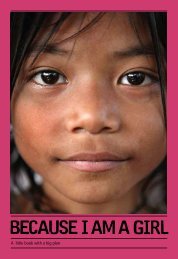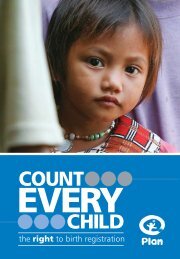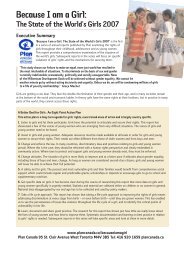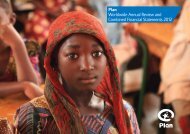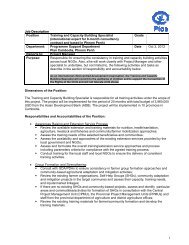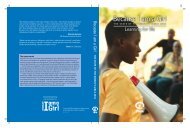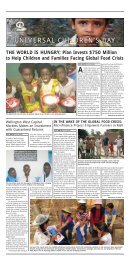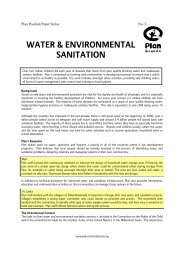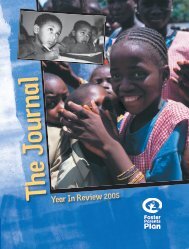Download the executive summary - Because I am a Girl
Download the executive summary - Because I am a Girl
Download the executive summary - Because I am a Girl
You also want an ePaper? Increase the reach of your titles
YUMPU automatically turns print PDFs into web optimized ePapers that Google loves.
Learning for LifeCall to Action1 Ensure any post-MDG fr<strong>am</strong>ework maintains a strong priority on Education, but broaden our<strong>am</strong>bition to include <strong>the</strong> successful completion of at least nine years of quality education, with anintentional emphasis on gender equality.EXECUTIVE SUMMARY2 Commit to undertake a gender review of government Education Sector Plans and support actionto address <strong>the</strong> identified gaps.3 Expand funding mechanisms to support quality education for girls.MDG 3 puts gender equality at <strong>the</strong> heart of international policy. It is an <strong>am</strong>bitious goal that hasto be tackled at all levels of society and will mean far-reaching changes in <strong>the</strong> world in which welive. How can we measure <strong>the</strong> status of girls and women within <strong>the</strong>ir f<strong>am</strong>ilies and communities tomonitor real gender equality? How can levels of gender-based violence be reduced and <strong>the</strong> equalityof decision-making at home and work be increased? How can we make sure that women are paidequally and girls equipped to play an equal role in society? Education of both girls and boys is key.Equality of opportunity at school, providing a good-quality education and making sure that girls canbenefit from it, is crucial. Education alone may not be sufficient to transform <strong>the</strong> society we live in,but transformation can never be achieved without it. By caring about how education can contributeto girls’ increased agency, educators and governments and girls <strong>the</strong>mselves can find ways to designan education that truly supports girls to live freer and more fulfilling lives, and transforms <strong>the</strong> worldaround <strong>the</strong>m.“I <strong>am</strong> <strong>the</strong> only one in my f<strong>am</strong>ily who attended university. I <strong>am</strong> a role model in my f<strong>am</strong>ily and mycommunity, and I always try to encourage <strong>the</strong> girls of my village to strive for <strong>the</strong> best despite <strong>the</strong>poverty that seems to be a barrier to <strong>the</strong>ir dre<strong>am</strong>s.”Firehiwot Yemane, 24, Ethiopia 30“No enduring solution to <strong>the</strong> major changes of our day – from climate change to political and economicinstability to poverty – can be solved without <strong>the</strong> full participation of <strong>the</strong> world’s women and girls. Thismeans paying real attention to <strong>the</strong> State of <strong>the</strong> World’s <strong>Girl</strong>s. By providing evidence and calls to action,Plan’s series of reports, and <strong>the</strong> ‘<strong>Because</strong> I <strong>am</strong> a <strong>Girl</strong>’ Global C<strong>am</strong>paign, help all of us to advancegender equality as our individual and collective responsibility.”Michelle BacheletUN Women Executive Director, Foreword, 2012 ‘<strong>Because</strong> I <strong>am</strong> a <strong>Girl</strong>’ reportTake action at: becausei<strong>am</strong>agirl.org<strong>Because</strong> I <strong>am</strong> a <strong>Girl</strong>t h e S t a t e o f t h e W o r l d ’ s G i r l s 2 0 1 2Learning for LifeM a r k P e n g e l l y12 1
Learning for Lifeas research for this report has found, at adolescence <strong>the</strong> pressures of poverty and discrimination meanthat girls leave school: to help at home; because <strong>the</strong>ir f<strong>am</strong>ilies are not convinced of <strong>the</strong> value of <strong>the</strong>ireducation; because <strong>the</strong>y experience violence at school; because <strong>the</strong>y get pregnant or married; becauseschool is too far away and <strong>the</strong>ir parents think <strong>the</strong>ir daughters, and <strong>the</strong>ir reputations, are at risk.Governments all over <strong>the</strong> world have a chance to change this, to make a commitment to nine years ofquality education and to acknowledge in <strong>the</strong>ir budgeting, and in <strong>the</strong>ir education sector plans, <strong>the</strong> specificneeds of adolescent girls; recognising <strong>the</strong> particular challenges <strong>the</strong>y face to achieve gender equality andsocial justice.This year, a new global initiative on education, led by <strong>the</strong> UN Secretary-General, accepts <strong>the</strong> imperativeto protect education budgets during hard times. It also states that, despite much progress in recent years,“<strong>the</strong> quality of education remains desperately low in many parts of <strong>the</strong> world”. The new post-MillenniumDevelopment Goals (MDG) agenda should prioritise <strong>the</strong> quality of learning in school and acknowledgethat, unless <strong>the</strong> needs of adolescent girls are taken on board, many of <strong>the</strong> internationally approved targetsof reducing poverty and achieving gender equality will never be met.The 2012 ‘<strong>Because</strong> I <strong>am</strong> a <strong>Girl</strong>’ report is calling for nine years of quality education for all as <strong>the</strong> keyto protecting and promoting girls’ rights to education; and enabling girls and young woman to play asignificant role in <strong>the</strong>ir communities and in breaking <strong>the</strong> intergenerational cycle of poverty.O l l i v i e r G i r a r dLearning for life“In Malawi, especially in rural areas, girls meet a lot of challenges and because I <strong>am</strong> a girl I would liketo fight for my rights and girls’ rights too. We are also human beings who need to be respected.”Elizabeth, secondary school student from Malawi 1Every girl has <strong>the</strong> right to education but <strong>the</strong>re are 39 million 11-15 year-old girls out of school. 2 The2012 ‘<strong>Because</strong> I <strong>am</strong> a <strong>Girl</strong>’ report, <strong>the</strong> sixth in <strong>the</strong> annual report series, focuses on girls’ education andis particularly concerned with what happens to girls when <strong>the</strong>y reach adolescence. At this age, <strong>the</strong>irdomestic and reproductive roles begin to dominate <strong>the</strong>ir lives at <strong>the</strong> expense of learning. Despite reachingglobal parity in primary school level enrolment 3 , completion rates for girls still lag behind boys, and,‘<strong>Because</strong> I <strong>am</strong> <strong>Girl</strong>’ is an annual report published by Plan which assesses <strong>the</strong> current state of <strong>the</strong> world’sgirls. While women and children are recognised in policy and planning, girls’ particular needs andrights are often ignored. These reports provide evidence, including <strong>the</strong> voices of girls <strong>the</strong>mselves, as towhy <strong>the</strong>y need to be treated differently from boys and from adult women. They also use informationfrom a small primary research study set up in 2006 to follow <strong>the</strong> lives of 142 girls from nine differentcountries. Previous reports include girls “In <strong>the</strong> Shadow of War”, “<strong>Girl</strong>s in <strong>the</strong> Global Economy”, “<strong>Girl</strong>sin a Changing Landscape” which looked at new opportunities in cities and at ICTs and “So, WhatAbout Boys?” which in 2011 looked at <strong>the</strong> role of men and boys in gender equality. The reports includerecommendations for action, showing policymakers and planners what can make a difference to girls’lives all over <strong>the</strong> world. Plan is an international development agency and has been working with childrenand <strong>the</strong>ir communities in 48 countries worldwide for 75 years.“<strong>Girl</strong>s’ education was not a priority for most people. Most people married off <strong>the</strong>ir young girls to escapefrom high levels of poverty. Water, health and food were <strong>the</strong> most pressing needs of <strong>the</strong> communities.”Ayesha, 14, South Sudan 4This report looks in detail at why, despite much effort and good will, girls still lose out at school and athome. How can we keep all girls in school, including <strong>the</strong> poorest and most marginalised, improve <strong>the</strong>quality of <strong>the</strong> education <strong>the</strong>y receive and empower <strong>the</strong>m to take <strong>the</strong>ir rightful place as equal citizens?As <strong>the</strong>y reach adolescence in particular, girls and young women need to be able to achieve <strong>the</strong>irpotential; quality learning for life is at <strong>the</strong> heart of this.Not just <strong>the</strong> means to an end“Education is a right, but it is not a reality for too many women and girls. Education sends a message –a message of confidence and hope. It tells that child: you have a future; what you think matters.”United Nations Secretary-General’s Global Initiative on Education 2012For more than 200 years, a strong moral argument has been made for education for girls, grounded inhuman rights and equality. Any argument in support of more and better education for all girls needs torecognise <strong>the</strong> intrinsic importance of education for girls’ empowerment, not just its value as a trainingground for <strong>the</strong> world’s future workers and mo<strong>the</strong>rs. 5 It is a view of education closely associated withhuman dignity, not simply as a means to a wider end.The Rights fr<strong>am</strong>ework 6Used in <strong>the</strong> report to analyse girls’ educational needs:• Rights to education: Access and participation.• Rights within education: Gender-aware educational environments, processes and outcomes.• Rights through education: Supports gender equality leading to wider social justice.1 Plan International. ‘<strong>Because</strong> I <strong>am</strong> a <strong>Girl</strong>: Elizabeth in her own words.’ March 2012. http://http://bcimagirl.tumblr.com/ (last accessed 12 April 2012).2 UNESCO. ‘Education For All Global Monitoring Report: The Hidden Crisis: Armed Conflict and Education.’ Paris: UNESCO, 2011. 3 United Nations. ‘TheMillennium Development Report 2012.’ New York: United Nations, 2012.4 Plan South Sudan. ‘Newsletter December 2012.’ Internal Document, 2012. 5 Unterhalter, E. ‘Gender, schooling and global social justice.‘ London: TaylorFrancis Routledge, 2007. 6 Subrahmanian, R<strong>am</strong>ya. ‘Gender equality in education: Definitions and measurements.’ International Journal of EducationalDevelopment 25, (2005) http://pearsonfoundation-irc.org/genderandeducation/PDF/1.2_Gender_equality_educat.pdf (last accessed 25 May 2012).2 3
Learning for LifeEnrolment is not enoughBarriers to girls’ educationP l a n“Maybe one day when my siblings are a bit older I could goback to school. I would learn and pass all my subjects, and <strong>the</strong>nI could have a better job and a better life. Sometimes, I dre<strong>am</strong>about becoming a teacher or maybe a nurse.”Talent, 14, ZimbabweToday, young people spend more of <strong>the</strong>ir adolescence in schoolthan ever before. Adolescent girls in 2009 had a mean of sixyears of education in <strong>the</strong>ir lifetimes – up from fewer than fouryears in 1990. 7 Global trends in population growth, improvedhealth and greater urbanisation have all contributed to thistrend, but <strong>the</strong> achievements are mainly due to significantincreases in investment and commitment to access to educationaround <strong>the</strong> world. 8It is right that <strong>the</strong>se achievements are celebrated – as <strong>the</strong>yare sure to be in 2015 when heads of state ga<strong>the</strong>r at <strong>the</strong> UnitedNations to report on progress against <strong>the</strong> Millennium Development Goals – but this is not <strong>the</strong> whole story.While <strong>the</strong> pace of increase in girls’ enrolment in South Asia, Sub-Saharan Africa and East Asia has beensignificant – and faster than boys’ – <strong>the</strong> girls who are seeing <strong>the</strong> greatest increase tend to be urban and rich. 9Even in countries on track to meet global targets for enrolment and gender parity, girls from <strong>the</strong> poorest,hardest to reach, or most discriminated against communities are still left behind. 10Enrolment is an inherently flawed measure of access. It is captured on one day – sometimes <strong>the</strong> first day – of<strong>the</strong> school year and can only really show whe<strong>the</strong>r children turned up to school on that day. 11 Enrolment is nota true measure of whe<strong>the</strong>r girls are actually going to school on a regular basis or of whe<strong>the</strong>r <strong>the</strong>y are learninganything while <strong>the</strong>re.In 2004, <strong>the</strong> <strong>am</strong>ount needed to be spent on basic education for all was less than <strong>the</strong> <strong>am</strong>ount <strong>the</strong> USAand Europe spent on ice cre<strong>am</strong> ($31 billion) and not much more than on cosmetics ($18 billion.) 12 Mostsignificantly, it is only one 70th of <strong>the</strong> $1.6 trillion <strong>the</strong> world spent on arms in 2010. 13In many regions of <strong>the</strong> world, we see three factors common to girls who have <strong>the</strong> least chance of going toschool and staying <strong>the</strong>re:• <strong>the</strong>y are poor;• <strong>the</strong>y live in rural areas;• <strong>the</strong>y come from ethnic groups that are discriminated against or excluded.In <strong>the</strong> poorest 20 per cent of households in <strong>the</strong> world, only 64 per cent of all school-aged children enrol inschool, compared to 90 per cent of children in <strong>the</strong> richest 20 per cent of homes. 14 When adding a genderdyn<strong>am</strong>ic to this statistic, a bleak picture emerges. <strong>Girl</strong>s in <strong>the</strong> poorest households are most likely to beexcluded from school altoge<strong>the</strong>r. 157 Lloyd, Cynthia B. (Ed.) ‘Growing Up Global: The Changing Transitions to Adulthood in Developing Countries’. Washington DC: National Academies Press,2005. 8 Lloyd, Cynthia B. ed. ‘Growing Up Global: The Changing Transitions to Adulthood in Developing Countries’. Washington DC: National AcademiesPress, 2005. 9 UNESCO. ‘Education For All Global Monitoring Report: The Hidden Crisis: Armed Conflict and Education.’ Paris: UNESCO, 2011. 10 Levine,Ruth, Cynthia Lloyd, Margaret Greene, and Caren Grown. ‘<strong>Girl</strong>s Count: A Global Investment and Action Agenda.’ Washington, DC: Centre for GlobalDevelopment, 2008. 11 Banjeree, Abhijit V. and Es<strong>the</strong>r Duflo. ‘Why Aren’t Children Learning?’ Development Outreach, 2011. 12 Halweil, Brian, LisaMastny, Erik Assadourian, Christopher Flavin, Hilary French, Gary Gardner, Danielle Nierenberg, Sandra Postel, Michael Renner, Radhika Sarin, Janet Sawin,Amy Vickers. ‘State of <strong>the</strong> World 2004: A Worldwatch Institute Report on Progress Toward a Sustainable Society.’ Washington DC: Worldwatch Institute,2004. 13 Stockholm International Peace Research Institute. ‘Background paper on SIPRI military expenditure data, 2010.’ Citing: Stockholm InternationalPeace Research Institute. ‘SIPRI Yearbook 2011: Arm<strong>am</strong>ents, Disarm<strong>am</strong>ent and International Security.’ Oxford University Press, July, 2011. 14 UNICEF.‘Progress for Children: Achieving <strong>the</strong> MDGs with Equity.’ New York: UNICEF, 2010. 15 Lake, Anthony. ‘UNGEI Global Conference on <strong>Girl</strong>s: OpeningCeremony Remarks Speech.’ Dakar, Senegal: UNCEF, 17 May 2010. http://www.unicef.org/media/media_53665.html (last accessed 23 May 2012).In a recent research study in seven African countries, Plan ex<strong>am</strong>ined <strong>the</strong> challenges adolescent girls faceto get in to, and to stay in, school. The issues are complex and numerous. 161 While primary education is nominally free in all <strong>the</strong> countries studied, all f<strong>am</strong>ilies noted that <strong>the</strong>y stillface a number of charges, even at primary level, for <strong>the</strong>ir children’s education, including <strong>the</strong> cost ofsupplies, uniforms and transport. In Ghana, 46 per cent of children interviewed felt that <strong>the</strong> lack ofschool materials and uniforms was <strong>the</strong> main difficulty faced in going to school, and a fur<strong>the</strong>r 14 percent cited <strong>the</strong>ir inability to pay school fees. 172 Teacher-pupil abuse and sexual exploitation is prevalent across all <strong>the</strong> countries. When asking aboutearly pregnancy, Plan’s researchers in Togo found that 16 per cent of <strong>the</strong> children interviewed n<strong>am</strong>ed ateacher as responsible for <strong>the</strong> pregnancy of a classmate. The figure was 15 per cent in Mali and 11 percent in Senegal. In Ghana, 75 per cent of children cited teachers as <strong>the</strong> main perpetrators of violence inschool; in Senegal <strong>the</strong> figure was 80 per cent.3 Early pregnancy is common and leads to drop-out, forever limiting a girl’s chances of finishing school, evenif she does return. In Liberia, 61 per cent of children knew of at least one girl who had fallen pregnant in <strong>the</strong>last two school years; only five per cent of children said that <strong>the</strong> girl(s) had returned to school after <strong>the</strong> birth.In some countries, girls exchanging sex for money to pay for school fees and materials, however negativelyviewed, is a common practice. Beliefs that <strong>the</strong> only role girls can have is as wives and mo<strong>the</strong>rs, have anegative impact on girls’ social development and <strong>the</strong>ir educational goals. In Ghana, 83 per cent of parentslisted <strong>the</strong> possibility of girls falling pregnant as a disadvantage of schooling girls.4 The high number of hours girls spend on household chores negatively affects <strong>the</strong>ir ability to learn. InGuinea Bissau, Plan’s study found that girls work an average of eight hours a day on household chorescompared to an average of three hours for boys. Tiredness and lack of time for schoolwork were listedas consequences of this burden.5 High levels of poverty affect both boys’ and girls’ nutrition, and few school-feeding progr<strong>am</strong>mes exist toalleviate this. In Mali, one group of children commented that <strong>the</strong>y had been forced to close <strong>the</strong>ir schoolcanteen this year due to lack of support from NGOs or <strong>the</strong> government, and were unable to bring foodfrom home due to bad harvests. This had a significant impact on overall attendance.When poor parents make a decision about which child is more likely to gain from education, whichis a long-term investment, a girl’s immediate usefulness as a caretaker, her worth as a bride, or hercontribution through domestic or o<strong>the</strong>r labour can be deemed more valuable than an uncertain andunproven return from her education in <strong>the</strong> future. 18Given resource constraints on <strong>the</strong> part of governments and donors, it makes sense to concentrate resourceswhere <strong>the</strong>y are most needed – and that is <strong>am</strong>ong <strong>the</strong> poorest and most marginalised communities.Conditional cash transfers and/or scholarships will be insufficient to address girls’ most critical needs,particularly for <strong>the</strong> poorest <strong>am</strong>ong <strong>the</strong>m, without complementary inputs to streng<strong>the</strong>n school quality. Thisis because <strong>the</strong> poorest girls attend <strong>the</strong> poorest schools and come from f<strong>am</strong>ilies with <strong>the</strong> least capacity, interms of time and education, to support and reinforce <strong>the</strong>ir learning. This might suggest a school-basedapproach, in which marginalised schools are identified for support with supplementary but limited resourcesalso provided to <strong>the</strong> neediest girls. Sustainability will require time; indeed, <strong>the</strong> time for a next generation ofgirls to be educated and empowered to take up positions of influence and leadership in <strong>the</strong>ir communities.Cynthia Lloyd16 Lucas, Natalie. ‘<strong>Girl</strong>s’ retention and performance in primary and secondary education. Makers and breakers: A research project to investigate <strong>the</strong>dyn<strong>am</strong>ic of factors influencing school retention and performance of girls in Africa’. Plan, 2012. (Unpublished). 17 Lucas, Natalie. ‘<strong>Girl</strong>s’ retention and performancein primary and secondary education. Makers and breakers: A research project to investigate <strong>the</strong> dyn<strong>am</strong>ic of factors influencing school retentionand performance of girls in Africa’. Plan, 2012. (Unpublished). 18 Plan International. ‘<strong>Because</strong> I <strong>am</strong> a <strong>Girl</strong>: The State of <strong>the</strong> World’s <strong>Girl</strong>s 2009, <strong>Girl</strong>s in <strong>the</strong>Global Economy: Adding it all Up’. Plan International, 2009.4 5
Learning for LifeWhat is learning?“My ma<strong>the</strong>matics teacher asked me to fall in love with him, but I found it difficult for me to do that.This bec<strong>am</strong>e a problem between us. Any small mistake or bad thing I did I <strong>am</strong> almost always punished.This was one of <strong>the</strong> reasons I hate school and dropped out.”Adolescent girl, Sierra Leone 19Learning is not just about numeracy, literacy or even life skills. What girls learn about <strong>the</strong>mselves – as girlsand as members of <strong>the</strong> communities and societies in which <strong>the</strong>y live – is also critical. The values that <strong>the</strong>school passes on to students, both boys and girls, are as important as <strong>the</strong> official curriculum.Are girls taught that <strong>the</strong>y are not as clever as boys? Are <strong>the</strong>y told that girls don’t do maths and science?Do <strong>the</strong>y learn that women should be subservient to men because all <strong>the</strong> pictures in <strong>the</strong> textbooks depict<strong>the</strong>m this way or because it’s always girls whom <strong>the</strong> teacher asks to clean <strong>the</strong> classrooms or fetch tea?Or are <strong>the</strong>y learning how to make decisions and choices and to understand <strong>the</strong> world, so that when <strong>the</strong>yleave school <strong>the</strong>y will have <strong>the</strong> power to lead lives <strong>the</strong>y value?Education alone is not a cure for all of society’s ills, but a good education can give girls <strong>the</strong> skills andcompetencies <strong>the</strong>y need to choose <strong>the</strong>ir own career path, have healthy positive relationships with <strong>the</strong>irpartners, f<strong>am</strong>ilies and friends, and enable <strong>the</strong>m to make positive decisions about <strong>the</strong>ir bodies and <strong>the</strong>ir health.As such, a quality education – what you learn and what it is like in school for you – is <strong>the</strong> key tounlocking opportunities in adulthood.“I think boys are confident enough and <strong>the</strong>y can ask questions in <strong>the</strong> class. This gives teachers <strong>the</strong> ideathat <strong>the</strong>y are understanding <strong>the</strong> topic and boys are intelligent. We girls also want to ask questions, butwe are shy and cannot ask questions. Thus, we become only listeners in <strong>the</strong> class.”<strong>Girl</strong>, Pakistan 20<strong>Girl</strong>s will not learn just by enrolling in oreven attending school regularly. Thereare a number of obstacles and challengesadolescent girls continue to face while <strong>the</strong>yare in education. By placing gender equality at<strong>the</strong> heart of learning, each of <strong>the</strong>se challengescan be turned into an opportunity. Teachertrainingcourses need to explore gender in away that allows teachers to reflect on <strong>the</strong>irown understanding, as well as to challenge<strong>the</strong> discrimination and beliefs that result ininequality. Educators can look not just at <strong>the</strong>number of resources and teachers, but athow those resources are being used and bywhom, and at what and how teachers areteaching. By looking at <strong>the</strong>se issues from <strong>the</strong>perspective of adolescent girls, educationsystems can remove <strong>the</strong> barriers which arepreventing girls from learning.19 Mukhopadhyay, M., N. Mudege, L. Wolmarans, and C. Hunter. ‘DFID PPA funded “Building Skills for Life for Adolescent girls’’ Progr<strong>am</strong>me: GlobalBaseline report prepared for Plan UK by KIT. Final Report.’ Amsterd<strong>am</strong>: KIT, 2012. 20 Page, Elspeth and Jyotsna Jha (Ed.). ‘Exploring <strong>the</strong> Bias: GenderStereotyping in Secondary Schools.’ London: Commonwealth Secretariat, 2009.L u c a T o m m a s i n iWhy learning for life is so important foradolescent girlsAdolescent girls stand at <strong>the</strong> doorway to adulthood. If adolescentgirls stay in school and obtain real skills, research shows that <strong>the</strong>ywill earn more income in <strong>the</strong> future, marry later, and have fewerand healthier children. In <strong>the</strong> longer term, secondary educationprotects girls against HIV and AIDS, sexual harassment andhuman trafficking. In short, secondary education, in combinationwith financial assets and life skills, is essential for adolescentempowerment, development and protection.The essential outcome of education should be concerned withwider social justice. Without education, equality goals will beunreachable. But education alone is not sufficient. In both LatinAmerica and <strong>the</strong> Middle East, recent increases in female education levels have not led to correspondingequality in <strong>the</strong> work-place or at home. 21 <strong>Girl</strong>s and young women still emerge struggling with <strong>the</strong> idea that<strong>the</strong>y are second-class citizens. If <strong>the</strong>y are to play an equal part in society, once <strong>the</strong>y finish <strong>the</strong>ir education,that education must be truly empowering and equip <strong>the</strong>m with <strong>the</strong> capacity and determination tochallenge <strong>the</strong> discrimination <strong>the</strong>y will inevitably face.<strong>Girl</strong>s taking controlEducation for girls goes beyond rights; it must be concerned also with what <strong>the</strong>y are able to do with thoserights in <strong>the</strong> key areas of <strong>the</strong>ir lives: health, relationships, work and citizenship.A good-quality education, for ex<strong>am</strong>ple, should make it possible for girls to make <strong>the</strong>ir own decisions andchoices about healthcare and reproduction. 22• Adolescent girls who are in school are likely to marry later.• They are less likely to have premarital sex and more likely to use contraception.• Even completion of primary school is strongly associated with later age at marriage, later age at firstbirth, and lower lifetime fertility. 23,24• Research shows that as women gain four additional years of education, fertility rates drop by one birth,but girls with fewer than seven years schooling are more likely to be married by age 18. 25• An eight-country study from 1987 to 1999 concluded that a girl’s education from secondary levelonwards is <strong>the</strong> most consistent factor in determining whe<strong>the</strong>r or not she will bear her first child whilestill an adolescent herself. 2621 Lanza Meneses, Martha. For Plan 2012 ‘<strong>Because</strong> I <strong>am</strong> a <strong>Girl</strong>’ report. Roudi, Farzaneh and Valentine M. Moghad<strong>am</strong>. ‘Empowering Women, DevelopingSociety: Female Education in <strong>the</strong> Middle East and North Africa.’ Washington DC: Population Reference Bureau, 2003. 22 Malhotra, Anju, Rohini Pandeand Caren Grown. ‘Impacts of Investments in Female Education on Gender Equality.’ Washington DC: ICRW, 2003; Herz, Barbara and Gene B. Sperling.‘What Works in <strong>Girl</strong>s’ Education: Evidence and Policies from <strong>the</strong> Developing World.’ New York: Council on Foreign Relations Press, 2004; Rihani, MayA, Lisa Kays and Stephanie Psaki. ‘Keeping <strong>the</strong> Promise: Five Benefits of <strong>Girl</strong>s’ Secondary Education.’ Washington DC: AED Academy for EducationalDevelopment, 2006. 23 DFID. ‘Choices for women: planned pregnancies, safe births and healthy newborns: The UK’s Fr<strong>am</strong>ework for Results for improvingreproductive, maternal and newborn health in <strong>the</strong> developing world.’ London: DFID, 2010. 24 Temin, Miri<strong>am</strong>, Ruth Levine, and Nandini Oomman. ‘Whyit’s <strong>the</strong> right time: Moving on Reproductive Health Goals by Focusing on Adolescent <strong>Girl</strong>s.’ Washington DC: Women Deliver, 2010. Citing: Ainsworth,Martha, and Innocent Semali. ‘Who is Most Likely to Die of AIDS? Socioeconomic Correlates of Adult Deaths in Kagera Region, Tanzania.’ In; Ainsworth,M., L. Fransen and M. Over (Eds.). ‘Confronting AIDS: Evidence from <strong>the</strong> Developing World.’ Brussels: The European Commission, 1998. Jejeebhoy,S. J., ‘Women’s Education, Autonomy, and Reproductive Behaviour: Experience from Developing Countries.’ Oxford: Clarendon Press, 1995; Lloyd,Cynthia and Barbara Mensch. ‘Implications of Formal Schooling for <strong>Girl</strong>s’ Transitions to Adulthood in Developing Countries.’ in (Eds.) Bledsoe, CarolineH., ‘Critical Perspectives on Schooling and Fertility in <strong>the</strong> Developing World.’ Washington DC: The National Academies Press, 1999; United Nations.‘Women’s Education and Fertility Behavior: Recent Evidence from <strong>the</strong> Demographic and Health Surveys.’ New York: United Nations, 1995. 25 Marphatia,Akanksha A., ‘Creating an enabling environment for girls’ and women’s participation in education.’ Paper presented at <strong>the</strong> United Nations Division for<strong>the</strong> Advancement of Women (DAW) Expert Group Meeting ‘Enhancing Participation of Women in Development through an Enabling Environment forAchieving Gender Equality and <strong>the</strong> Advancement of Women,’ Bangkok, Thailand, 8-11 November 2005. Citing: Klasen, S. ‘Does Gender Inequality ReduceGrowth and Development? Evidence from Cross-Country Regressions. Policy Research Report on Gender and Development Working Paper 7.’ WashingtonDC: World Bank, 1999. 26 Temin, Miri<strong>am</strong>, Ruth Levine, and Nandini Oomman. ‘Why it’s <strong>the</strong> right time: Moving on Reproductive Health Goals by Focusingon Adolescent <strong>Girl</strong>s.’ Washington DC: Women Deliver, 2010. Citing: Gupta, Neeru and Mary Mahy. ‘Adolescent Childbearing in Sub-Saharan Africa: Canincreased schooling alone raise ages at first birth?’ Demographic Research, 8, 4 (2003), http://www.demographic-research.org/Volumes/Vol8/4/8-4.pdf.6 7M a r k P e n g e l l y
Learning for LifeThe protective role of education 27There has been a lot of work on breaking <strong>the</strong> silence around <strong>the</strong> violence against girls which can occurin and around schools. <strong>Girl</strong>s experience gender-based violence on <strong>the</strong> way to school, at school, and as aconsequence of aspirations nurtured through school. 28 What this focus in research has perhaps masked is<strong>the</strong> value of education in providing girls with confidence, insights and networks to challenge <strong>the</strong> genderinequitable norms and power balances which are associated with violence.Not only are women who are educated to secondary level or higher less likely than <strong>the</strong>ir non-educatedor primary-educated counterparts to experience violence, but men who are educated to secondary levelor higher are less likely than <strong>the</strong>ir non-educated or primary-educated counterparts to perpetrate violence:• Women in 11 out of 14 countries analysed, who had been educated to secondary level or higher, wereless likely to experience violence.• In nine out of <strong>the</strong> 14 countries, a smaller proportion of husbands with higher levels of education havecarried out physical or sexual violence. It appears that more schooling for men may limit some levels ofphysical and sexual violence against <strong>the</strong>ir wives.• For men in most countries, continuing schooling beyond <strong>the</strong> primary level decreases <strong>the</strong> risk ofcommitting violence.Education seems to shift attitudes and cycles of violence can be broken as women become more likely toreport it, or to join toge<strong>the</strong>r to fight against gender-based violence and to c<strong>am</strong>paign for progressive laws.In Nigeria, 71 per cent of women with no education think that violence is justified when a woman leaves<strong>the</strong> house without telling her husband, compared to 33 per cent of women with secondary educationor higher. In Kenya, 61 per cent of women with no education think that violence is justified if a womanargues with her husband, compared to 52 per cent of primary educated women, but only 27 per cent ofwomen with secondary education or higher.(For a fuller account and <strong>the</strong> accompanying data please go to <strong>the</strong> main 2012 ‘<strong>Because</strong> I <strong>am</strong> a <strong>Girl</strong>’ report.)J i r o O s eThe true promise of equalityThere is nowhere in <strong>the</strong> world today where women are equalto men. Four categories of empowerment have been identifiedby <strong>the</strong> World Economic Forum. These are: equality in economicparticipation and opportunity, educational attainment, healthand survival, and political empowerment. But in not one countrydo women’s achievements match or exceed men’s. 29 This meansthat whenever and wherever girls and women strive for <strong>the</strong> s<strong>am</strong>etreatment and access as boys and men, <strong>the</strong>y are still held back,paid less, or not heard.Discrimination affects <strong>the</strong> lives of girls and women frominfancy to adulthood. It contributes to high infant and childhoodmortality, to low educational achievement, and to failures toprotect children from harm. It also affects <strong>the</strong> economic survivalof f<strong>am</strong>ilies and <strong>the</strong> participation of children and young people inf<strong>am</strong>ily and community decisions. Many violations of children’srights have <strong>the</strong>ir roots in gender-based inequality, exclusion andinjustice. This report argues that education should play both aprotective and a transformative role in building a society thatrespects <strong>the</strong> rights of all its members. In focusing on <strong>the</strong> experiences of adolescent girls and <strong>the</strong> particularbarriers <strong>the</strong>y face in accessing a good-quality education, we are advocating not just for <strong>the</strong>ir rights asindividuals but for <strong>the</strong>ir right to be active and creative members of <strong>the</strong> communities <strong>the</strong>y live in. The girlswe have met and talked to in <strong>the</strong> course of our research have demonstrated <strong>the</strong>ir capabilities, enthusiasmand determination. They know <strong>the</strong> value of education, and listening to <strong>the</strong> voices of Talent, Gloria,Ayesha and Elizabeth we can see <strong>the</strong>m fighting for <strong>the</strong> choices <strong>the</strong>y want to make. In supporting girls like<strong>the</strong>se we are also supporting something broader – <strong>the</strong> true promise of equality.P a o l o B l a c k f o r t h e Y o u n g H e a l t h P r o g r a m m e27 Charley Nussey, Institute of Education, University of London. 28 Leach, Fiona. ‘Gender Violence in Schools in <strong>the</strong> Developing World.’ Gender and Education,18, No. 1 (2006); Laurie, Emily. ‘Plan’s Learn Without Fear c<strong>am</strong>paign: C<strong>am</strong>paign Progress Report.’ Woking: Plan International, 2010; Leach, Fionaand Claudia Mitchell (Eds.). ‘Combating Gender Violence In and Around Schools.’ Stoke on Trent: Trenth<strong>am</strong> Books, 2006; Parkes, Jenny and Jo Heslop.‘Stop Violence Against <strong>Girl</strong>s in School: A cross-country analysis of baseline research from Ghana, Kenya and Moz<strong>am</strong>bique.’ London: ActionAid, 2011;Antonowicz, Laetitia. ‘Too Often in Silence: A Report on School-Based Violence in West and Central Africa.’ UNICEF, Plan West Africa, Save <strong>the</strong> ChildrenSweden West Africa and ActionAid, 2010.Gloria <strong>the</strong> mechanic“Sometimes when I go home wearing overalls, everyone starts laughing at me. They shout, ‘Womenshould not be wearing overalls! It’s not for a woman! It’s a man’s work!’ They think that I <strong>am</strong> a bigembarrassment. But I stay strong because I know I <strong>am</strong> doing <strong>the</strong> right thing. I <strong>am</strong> very happy andvery proud: what a man can do, a woman can also do.I <strong>am</strong> one of <strong>the</strong> first female mechanics to train at Juba Technical High School. Look around South Sudanand you see male mechanics everywhere: no women. But I say it’s good for me to take on <strong>the</strong> role.I <strong>am</strong> studying everything about cars. I have learned so many things – how to take apart <strong>the</strong> engine;<strong>the</strong> gears; <strong>the</strong> radiator. If a car fails, I know how to fix it.In South Sudan, if you don’t have contacts, you will search up and down and you will not find ajob. But if you know how to build, or be a carpenter, or be an auto mechanic, it’s much easier: you’llget a job. That’s why I decided to come to this training school.When you are married in this country, <strong>the</strong> husband will not allow you to work. Even if you read,even if you have finished all your school, he will not allow you to work. In <strong>the</strong> future, I want to be avery successful auto mechanic. I think I <strong>am</strong> a good role model. Sometimes people in high positionsencourage me and advise me and tell me I’m a good ex<strong>am</strong>ple. I make <strong>the</strong>m happy as <strong>the</strong>y just cannotbelieve that a lady can do such things!”Gloria Joy, 18, Trainee Auto Mechanic, Plan International’s Juba Technical High School, South Sudan29 Hausmann, Richard, Laura D. Tyson and Saadia Zahidi. ‘The Global Gender Gap Report 2011.’ Geneva: World Economic Forum, 2011. 30 FAWE.‘Yemane plans to go for <strong>the</strong> highest degree available.’ http://www.fawe.org/resource/voices/yemane/index.php (last accessed 29 May 2012).8 9
Learning for LifeP L A N‘Real Choices, Real Lives’ updateNow in its sixth year, <strong>the</strong> ‘Real Choices, Real Lives’ study follows 142 girls living in nine countries around<strong>the</strong> world – Benin, Brazil, C<strong>am</strong>bodia, Dominican Republic, El Salvador, Philippines, Togo, Uganda andVietn<strong>am</strong>. The study aims to achieve a better understanding of young girls’ lives through in-depthinterviews and focus-group discussions with <strong>the</strong>ir relatives and o<strong>the</strong>rs who live around <strong>the</strong>m. The majorityof <strong>the</strong> girls taking part in <strong>the</strong> study are now ei<strong>the</strong>r attending a pre-school facility or are at primary school.A small number of girls are still not enrolled in school, <strong>the</strong>ir parents citing distance to school and <strong>the</strong> girls’poor health as reasons for this.Generally, parents continue to express pride in <strong>the</strong>ir girls’ progress in school. At <strong>the</strong> s<strong>am</strong>e time, <strong>the</strong>yare becoming increasingly vocal about <strong>the</strong> quality of education <strong>the</strong>ir daughters receive. Several parentsrepeatedly asserted that <strong>the</strong>y would send <strong>the</strong>ir daughters to better schools if <strong>the</strong>y could afford to do so orif it were safe for <strong>the</strong> girls to travel on <strong>the</strong>ir own to a better school fur<strong>the</strong>r from home.Many of <strong>the</strong> f<strong>am</strong>ilies taking part in <strong>the</strong> study have reported that <strong>the</strong> cost of living has risen over <strong>the</strong>past year, and many have had to cover additional medical costs. For most, <strong>the</strong> greater part of <strong>the</strong>irincome is spent on food. But for many, raising a young f<strong>am</strong>ily also means having to cover some of <strong>the</strong>costs of sending <strong>the</strong>ir children to school.Now we are sixThis year, <strong>the</strong> girls taking part in Plan’s cohort studywill reach <strong>the</strong> age of six – quite a milestone in <strong>the</strong>irlives. Most of <strong>the</strong>m are now attending school, so thisis <strong>the</strong> year when influences outside <strong>the</strong> home start tohave a bigger impact on <strong>the</strong>ir lives. They will meet awider range of people and although <strong>the</strong>ir mo<strong>the</strong>rs willremain <strong>the</strong> key influences and role models, teachers,friends and older children will also become increasinglyimportant to <strong>the</strong>m.At home, it is <strong>the</strong> women of <strong>the</strong> f<strong>am</strong>ily whom<strong>the</strong> girls spend <strong>the</strong>ir time with and <strong>the</strong>y are alreadymimicking female household work while <strong>the</strong>y play andsome, even at six, are being set household tasks clearlydefined by gender. Chhea from C<strong>am</strong>bodia wants tobe a teacher but also told us: “I like to wash dishes aswell and help my mo<strong>the</strong>r to collect firewood.”Life storiesChheaFor this year’s report we have conducted in-depthinterviews with <strong>the</strong> girls’ mo<strong>the</strong>rs, taking <strong>the</strong>m on<strong>the</strong> journey from <strong>the</strong>ir own childhood, through <strong>the</strong>life changes and critical decisions made during adolescence, to <strong>the</strong>ir lives today as mo<strong>the</strong>rs. Last yearwe spoke with almost 100 of <strong>the</strong> girls’ fa<strong>the</strong>rs. The differences between <strong>the</strong>se two sets of interviewsare illuminating, particularly in terms of <strong>the</strong> men’s experiences of adolescence. This is when life’sopportunities seem to open up for boys and where <strong>the</strong>y close down for girls.Most of <strong>the</strong> girls’ mo<strong>the</strong>rs tell of lives lived through interrupted <strong>am</strong>bitions and failed dre<strong>am</strong>s. Manyreported entering domestic service at adolescence. They recalled that this not only had a negative impacton <strong>the</strong>ir formal education, but also that many of <strong>the</strong>m were abused and ill-treated, sometimes by <strong>the</strong>irown relatives. Through <strong>the</strong> women’s life stories, we see how adolescence was such a critical time for<strong>the</strong>m. This was when <strong>the</strong>y were given more household responsibilities which ultimately affected <strong>the</strong>ireducational prospects. Several of <strong>the</strong>m were married at around <strong>the</strong> age of 14, and this marked <strong>the</strong> pointat which <strong>the</strong>ir formal education stopped. For those girlswho become pregnant, <strong>the</strong> school environment becomesan unforgiving place, and pregnancy also effectively ends<strong>the</strong>ir school career.Changing timesWhile <strong>the</strong> women describe clearly defined householddivisions of labour – and it is apparent that <strong>the</strong>se male/female divisions are widely followed – what does seemto be slowly emerging is <strong>the</strong> recognition that schoolagegirls need extra time for homework, leisure andrest. Mercedes, Noelia’s grandmo<strong>the</strong>r in <strong>the</strong> DominicanRepublic, says: “I would like <strong>the</strong>m always to rememberwhat I wanted <strong>the</strong>m to be. That <strong>the</strong>y learn, that <strong>the</strong>ystudy, that I never said: you don’t go to school todaybecause you have to wash <strong>the</strong> clo<strong>the</strong>s, because you haveto wash <strong>the</strong> dishes, or because you have to do something.No, I left <strong>the</strong>m alone so that <strong>the</strong>y could study.”As women who are mostly in <strong>the</strong>ir twenties andthirties, <strong>the</strong> mo<strong>the</strong>rs of <strong>the</strong> girls have <strong>the</strong>mselves grownup in a time of rapid social change. On <strong>the</strong> whole, <strong>the</strong>women acknowledge that <strong>the</strong>y are living in a time of change and that greater opportunities now exist forwomen and for girls.The most striking responses overall are <strong>the</strong> women’s overwhelmingly positive attitude towards girls’education. Almost all of <strong>the</strong> women interviewed responded to <strong>the</strong> question “What are your hopes foryour daughter’s future?” by saying that <strong>the</strong>y would hope for <strong>the</strong>ir daughters to be better educated than<strong>the</strong>y were. Some went on to explain that in small ways <strong>the</strong>y are disrupting <strong>the</strong> status quo in preparing<strong>the</strong>ir daughters for a better future. Juliet’s mo<strong>the</strong>r Rose, in Uganda, explains: “I always think about <strong>the</strong>irfuture. I have always encouraged <strong>the</strong>m to go to school. I bought goats and chicken for <strong>the</strong> boys andbought plots of land for <strong>the</strong> girls, since <strong>the</strong> boys canalways find land at <strong>the</strong>ir fa<strong>the</strong>r’s place.”Six year-old Charolyn from <strong>the</strong> Dominican Republic isdefinitely picking up on <strong>the</strong> aspirations of her mo<strong>the</strong>r’sgeneration. When asked what she wants to do when shegrows up, her confident response is, “I want to go touniversity”.Across almost every one of <strong>the</strong> f<strong>am</strong>ilies with daughtersin <strong>the</strong> Cohort Study, <strong>the</strong> recurring refrain “thingsare changing” is a reason for optimism. Mo<strong>the</strong>rs inparticular want a different and better life for <strong>the</strong>ir girlsand see education as being <strong>the</strong> route to this. Will <strong>the</strong>ircommitment be enough to overcome <strong>the</strong> combinedobstacles of poverty and entrenched ideas of male andfemale roles? Can <strong>the</strong>se six year-old girls realise <strong>the</strong>irfull potential in societies and f<strong>am</strong>ilies where <strong>the</strong>ir rights,especially to an education, are respected? As we continueto track <strong>the</strong> girls through <strong>the</strong>ir first decade of life, ourCharolyn optimism will be tested as poverty and discriminationundermine everybody’s good intentions.10 11P L A NP L A NNoelia and hergrandmo<strong>the</strong>r



